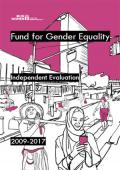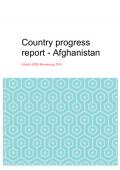What's New
Displaying results 1431 - 1440 of 4924

Resource | Publications,
This report contains the findings and recommendations of the first independent evaluation commissioned by UN Women’s Fund for Gender Equality (FGE), assessing USD 84 million invested through 121 grants across 80 countries since the FGE’s creation in 2009.
The evaluation found that the FGE implemented everything it set out to do in its strategies between 2009 and 2017. It directly touched the lives of an estimated 535,800 people, benefitting millions more through policy-level impact. The key contributions, it concluded, have entailed developing skills, addressing social norms to influence change, and establishing gender-responsive governance structures—all of which enabled greater women’s political and economic participation. The FGE helps legitimize women’s organizations and supports their learning through a culture of accompaniment. The evaluation also found that civil society sees the FGE as an important and necessary mechanism.

Resource | Presentations,
Presented by
Eamonn Murphy
Regional Director
UNAIDS Asia and the Pacific
September 5, 2018 Bangkok

Resource | Guidelines,
Nine out of 10 people living with HIV are adults in their most productive years. In the most affected countries, HIV takes a direct toll on markets, investments, services and education.
Ending AIDS is everybody’s business and will need collaboration between both the public sector and the private sector. Ending AIDS by 2030 needs effective action on: HIV testing, prevention, treatment and care, human rights solutions-oriented approaches by the business community are required in each of these areas.

Resource | Publications,
At the 2011 United Nations General Assembly High-Level Meeting on AIDS that took place in June in New York, Member States adopted a new Political Declaration which contained new targets to effectively respond to the AIDS epidemic. The 2011 Political Declaration mandates UNAIDS to support countries in reporting back on progress made towards achieving the new commitments. It also provides for the UN Secretary-General to report regularly to the General Assembly on progress achieved in realizing these commitments.
Afghanistan is experiencing a low and concentrated HIV epidemic and HIV is a public health concern among the key affected and vulnerable populations.

Resource | Publications,
At the 2011 United Nations General Assembly High-Level Meeting on AIDS that took place in June in New York, Member States adopted a new Political Declaration which contained new targets to effectively respond to the AIDS epidemic. The 2011 Political Declaration mandates UNAIDS to support countries in reporting back on progress made towards achieving the new commitments. It also provides for the UN Secretary-General to report regularly to the General Assembly on progress achieved in realizing these commitments.
Till 1st December 2017, 5,586 HIV positive cases were detected in Bangladesh of whom 865 were new. Most of the newly identified people living with HIV (PLHIV) were concentrated in Dhaka (54%), Chittagong (21%), Khulna (10%) and Sylhet divisions (6%).

Resource | Publications,
At the 2011 United Nations General Assembly High-Level Meeting on AIDS that took place in June in New York, Member States adopted a new Political Declaration which contained new targets to effectively respond to the AIDS epidemic. The 2011 Political Declaration mandates UNAIDS to support countries in reporting back on progress made towards achieving the new commitments. It also provides for the UN Secretary-General to report regularly to the General Assembly on progress achieved in realizing these commitments.
The Government of Cambodia has been a global leader in addressing HIV/AIDS for the past
25 years. As of December 2017, Cambodia had diagnosed approximately 85% of the estimated population of PLHIV, placed all diagnosed PLHIV on ART, and has documented significant viral load suppression of PLHIV on ART.

Resource | Publications,
At the 2011 United Nations General Assembly High-Level Meeting on AIDS that took place in June in New York, Member States adopted a new Political Declaration which contained new targets to effectively respond to the AIDS epidemic. The 2011 Political Declaration mandates UNAIDS to support countries in reporting back on progress made towards achieving the new commitments. It also provides for the UN Secretary-General to report regularly to the General Assembly on progress achieved in realizing these commitments.
China actively promotes the scaling-up of HIV testing and has made remarkable achievements in recent years. Along with the increment of annual amount of HIV testing, a huge number of cases diagnosed and identified.

Resource | Publications,
At the 2011 United Nations General Assembly High-Level Meeting on AIDS that took place in June in New York, Member States adopted a new Political Declaration which contained new targets to effectively respond to the AIDS epidemic. The 2011 Political Declaration mandates UNAIDS to support countries in reporting back on progress made towards achieving the new commitments. It also provides for the UN Secretary-General to report regularly to the General Assembly on progress achieved in realizing these commitments.
The preparation of the 2017 Global AIDS Progress Report (GAPR) for the Cook Islands was facilitated and compiled by the Ministry of Health, with relevant government ministries, non-government organizations and civil society involved in the response to HIV/AIDS and STIs. Collection of data for this report was carried out in consultation with ministry of health staff and various stakeholders throughout 2017. Data were collated and analysed by MOH for the completion of this report.

Resource | Publications,
At the 2011 United Nations General Assembly High-Level Meeting on AIDS that took place in June in New York, Member States adopted a new Political Declaration which contained new targets to effectively respond to the AIDS epidemic. The 2011 Political Declaration mandates UNAIDS to support countries in reporting back on progress made towards achieving the new commitments. It also provides for the UN Secretary-General to report regularly to the General Assembly on progress achieved in realizing these commitments.
The impact of the HIV/AIDS epidemic on the country’s economy and human development index remains high hence Fiji will continue to intensify the implementation of proven interventions to reverse the trend of HIV in the country consciously.

Resource | Publications,
At the 2011 United Nations General Assembly High-Level Meeting on AIDS that took place in June in New York, Member States adopted a new Political Declaration which contained new targets to effectively respond to the AIDS epidemic. The 2011 Political Declaration mandates UNAIDS to support countries in reporting back on progress made towards achieving the new commitments. It also provides for the UN Secretary-General to report regularly to the General Assembly on progress achieved in realizing these commitments.
Pakistan has an estimated 133,299 people living with HIV. The HIV epidemic in the country is concentrated in key populations namely: people who inject drugs (PWID), male, female and transgender sex workers (MSW, FSW & TGSW), men who have sex with men (MSM) and transgenders.





